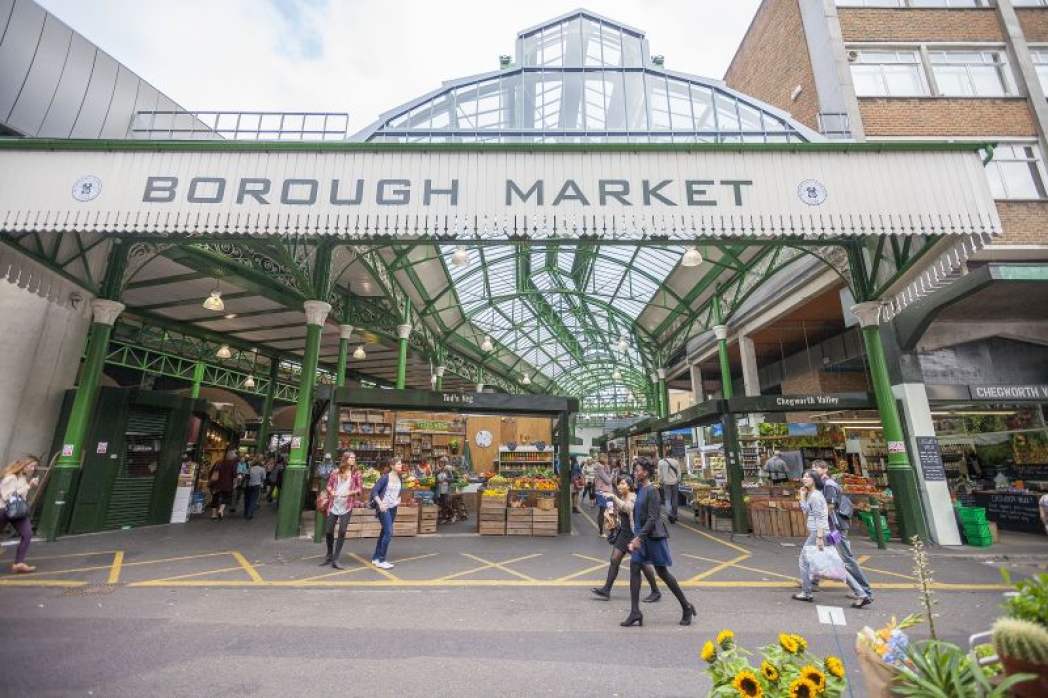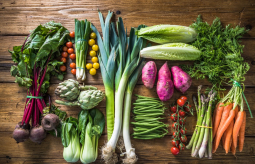Ultra local, zero wasting, fresh tasting: London’s oldest market is making space for the hottest ideas in global food trading, discovers Anna Blewett
If you think you know Borough Market, London’s oldest food market and arguably the spiritual home to the British food renaissance, here’s something you may have missed. Off Borough High Street, inside the market’s grand front gateway where the air is rich with aromas of roasting chicken, melting cheese and the sharp tang of fish sauce, is a plain, unremarkable doorway. Hidden from view by the snaking line of hungry visitors queuing for the handmade pasta at Padella, it’s a portal to the workings of a British institution with an unexpectedly principled mission. If you’ve a discerning palate and a hunger for gastronomic epiphanies, you’ve probably walked Borough’s Victorian cart tracks slurping something amazing from a bursting paper napkin.
A Parliamentary act of 1754 enshrined the market’s existence in law for perpetuity; the charity that runs the the sprawling community of traders from a network of offices straddling the iconic railway arches takes a similarly long view. Progressive policies on food waste (all traders distribute surplus food to local charities via Plan Zheroes) and packaging (no single-use plastics allowed) regulate the cacophony of colour, sound, aroma and taste, bringing ethics and commerce together in unexpected harmony. “My charitable objective is to provide a market for the benefit of the people of St Saviour’s parish,” smiles the market’s managing director Darren Heneghen, who, along with ten trustees, oversees measures that feed the local community, body and soul. “There are plenty of issues in London that need to be addressed and places like Borough Market need to be part of that.”
MARKET LIFE
I meet Darren in the Trust’s eagle’s nest boardroom, with bird’s-eye views over huge wheels of pale Alpine cheese, mountainous heaps of cinnamon buns and throngs of happy shoppers weaving between them. “That’s where the magic happens, out there,” Darren points out. “We just try to guide and cajole it.” With 156 traders and 15.5 million annual visitors crowding into the site, that’s some task. Each year more oversees tourists flock to Borough each year than visit Wales. “People come for an experience,” says Darren. “Looking out you can hear people talking to each other. Go to a major supermarket and it’s a silent experience; people are just pushing their trolleys around in silence. Here people are chatting, holding things up to show each other, tasting, sharing their opinion.”
And of course that whole conversation is echoed and amplified on social media: the drool-worthy salted caramel custard oozing from Bread Ahead’s sell-out donuts, physics-defying melty cheese at Kappacasein and freshly-shucked oysters from Richard Haward picked apart on Instagram, Twitter and Facebook. “Our channels hold a whole conversation that replicates those in the physical space: ‘What’s that? What did it taste like? Can I get that back home?’”
Walking through the market’s alleys, railway bridges criss cross overhead, enclosing the space and intensifying the sense of bustle and commerce: of people on the move. This corner of Southwark, like many neighbourhoods of London, has been subject to the creeping gentrification that could kill the character so beloved by long-time visitors. Along with the rest of the capital the market has become cleaner, shinier and sleeker, but here the process can be measured in centuries, rather than years. A food market has been held on the site for around 1,000 years, dating back at least to the days when Anglo-Saxon monarch Ethelread the Unready was battling marauding Danes for control of the Thames.
Southwark’s market flourished thanks to its location: close enough to the city of London to profit from residents’ wealth but just beyond the reach of toll collectors. “We like to think of it as the world’s first tax haven,” smiles Darren. The modern era has seen the market grapple with its historical destiny. “Twenty five years ago this whole part of London was quite dodgy and the trustees were overseeing a market in terminal decline,” says Darren. The turning point came as the traders twigged the public demand for the ingredients only available to chefs. “The wholesalers realised their fantastic produce was being promoted on television by the Michelin-starred chefs they supplied, but that viewers had no way of getting hold of it,” says Darren.
Daytime opening was tentatively trialled, with the market gradually evolving into a site that welcomes hungry home cooks from all over the globe. “We’ve been a symbol, I think, of how British food has developed over the years.” Others agree. The Trethowan family, makers of Gorwydd Caerphilly and Pitchfork Cheddar, have had a stall at the market since the early 2000s. “As cheese producers and wholesalers, our Borough pitch is our ‘shop front’, so to speak,” says Todd Trethowan. “People like to know the story behind their food and speak to the people who make or grow it. Borough Market has changed over the years, becoming more touristy, but it retains its reputation as a place to find the best produce. It’s a place where we’re able to supply international visitors to the city, local regulars, and top chefs, all from a single stall.”
BREAKING BREAD
“Borough Market is a magnet for foodies from all over the world,” agrees Sean Cannon, who in 2011 quit his career as an actor to set up his stall of British charcuterie under the name Cannon & Cannon. “People come here to celebrate the quality and variety of food that’s produced. Being part of that puts British charcuterie on the map; it’s everything to us.” The market’s community of traders and punters was sorely tested in June 2017, when three knifemen ran through the hallowed streets stabbing at bystanders as part of a larger terrorist attack that claimed eight victims. “For us it was as if someone had come into our home,” frowns Darren. “It was a shock. The thing that brings communities together is breaking bread together – why did they pick on us? You think you’re prepared but when it happens to you it’s incredibly personal.” The brave acts of traders and their staff made the market headline news around the world. “Fear actually wasn’t the overriding emotion; it was more resilience, incredulity, and a massive determination to get back on our feet. We were closed for 10 days because it was such a complicated scene, but when we reopened the whole community came together. All the traders were united. One of our traders, Paul Wheeler, was nominated to ring the bell at the start of trading; he nearly pulled the bell off the wall.”
Two years on the horror of that night has faded. The market is working hard to reflect the four corners of the British Isles, hosting pop-up stalls from small makers. “We actively source talent,” says Darren, “so it’s more like picking a premiership football team than overseeing a long waiting list.” Plans are afoot to allow home growers to sell excess produce alongside commercial farmers, an idea borrowed from Barcelona’s famous food markets. “An ultra local market says ‘You’ve got too many tomatoes to eat; come here and we’ll charge you a pound – or whatever – for a pitch to sell them’,” says Darren. “It’s a way for Londoners who have more produce than they can keep up with to share it with the public.” It’s also a canny way for the market to stay connected with its roots, bring fresh faces to the tarmac and keep it real for Londoners who have to jostle through crowds of Instagramming tourists to get their sourdough. “We’ll either get a million people want to come and do this or no-one at all,” says Darren. “So it’s an experiment. But hey, it’s the right thing to do.”
-
Blog
• 4 weeks ago -
Blog
• 4 weeks ago -
Blog
• one month ago -
Blog
• 2 months ago
-
The Best British Easter Eggs 2024
4 weeks ago -
Our pick of the bunch for your Easter table
4 weeks ago -
Five Easy Ways to Reduce Food Waste
one month ago















